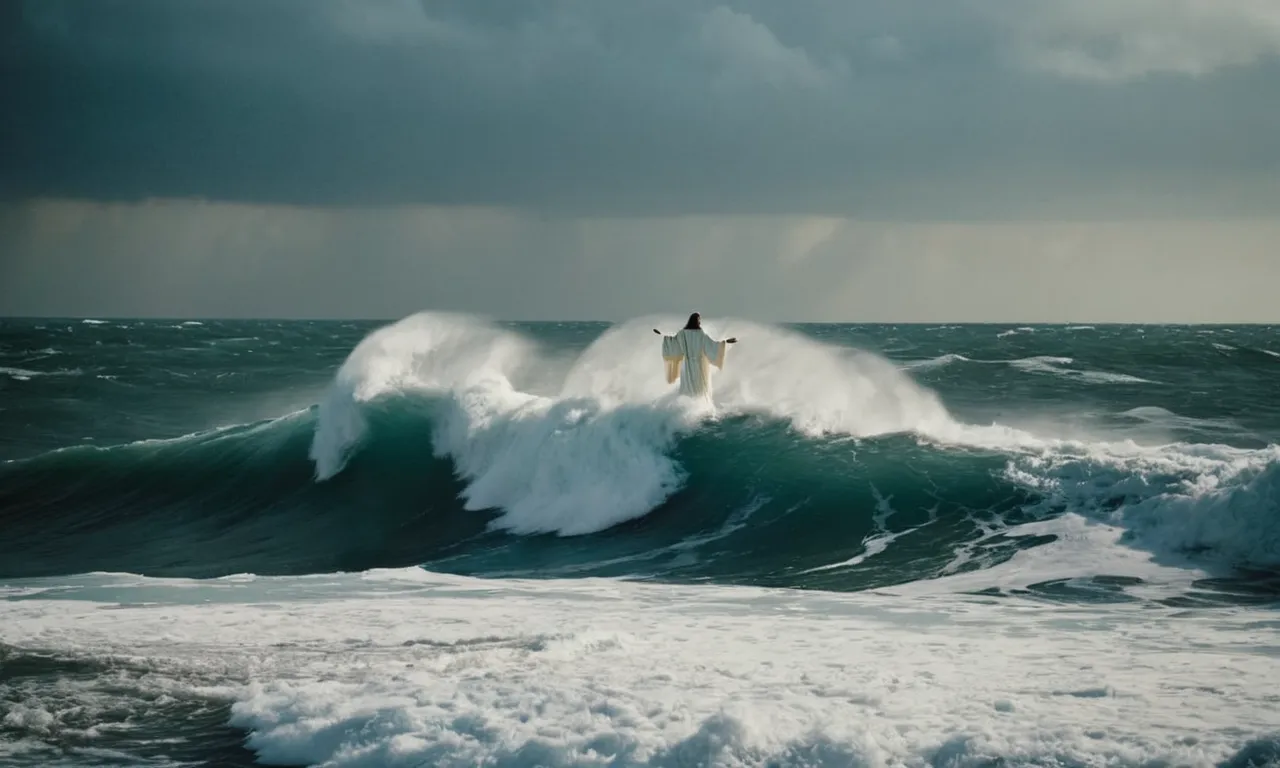How Many Times Did Jesus Calm The Storm?
Storms can be terrifying forces of nature that leave us feeling powerless. But according to the Bible, Jesus had power even over wind and waves when he calmed storms on two different occasions.
If you’re short on time, here’s a quick answer to your question: Jesus calmed the storm two times as recorded in the Gospels – once on the Sea of Galilee (Mark 4:35-41) and again by walking on water to reach his disciples (Matthew 14:22-33).
In this comprehensive article, we will examine both Gospel accounts in depth, considering the symbolism and significance behind Jesus’ miracles of stilling the storms. We’ll also compare and contrast details across the two stories to gain deeper insight into these awe-inspiring acts.
The First Storm Jesus Calmed
The Situation: Crossing the Sea of Galilee
One day, Jesus told his disciples, “Let us go over to the other side of the lake.” So they got into a boat and set out across the Sea of Galilee. This large freshwater lake, also known as Lake Tiberias, is situated in northern Israel. As night fell, Jesus was asleep in the stern of the boat.
Suddenly a ferocious storm swept down upon them. The winds roared and huge waves started crashing over the boat, threatening to swamp it. The disciples were terrified and frantically tried to keep the boat afloat.
Jesus Calms the Storm with a Command
In desperation, the disciples woke Jesus up, shouting “Teacher, don’t you care if we drown?” Jesus got up and rebuked the wind and waves, saying “Peace, be still!” Instantly the storm ceased, the winds died down, and the sea became perfectly calm.
The disciples were awestruck that even the wind and waves obeyed Jesus’ voice. They wondered, “Who is this man, that even the winds and waves obey him?” This amazing miracle clearly revealed Jesus’ divine authority and power over the forces of nature.
The Disciples’ Reaction of Fear and Awe
The disciples were initially afraid they would perish in the storm, but after Jesus stilled it, they were filled with even greater fear and awe. This life-threatening storm and miraculous rescue left a deep impression on them.
They marveled, “What manner of man is this, that even the wind and the sea obey him!” They gained greater insight into Jesus’ true divine identity and were even more convinced he was no ordinary man, but the very Son of God.
This awe-inspiring display of Jesus’ authority over creation increased their faith in him.
Jesus’ power to instantly calm the raging storm revealed his divinity and lordship over all creation. It showed he is the promised Messiah who has authority over nature, can protect his people, and bring them safely to their destination despite overwhelming obstacles.
The disciples’ initial lack of faith was transformed into reverent awe and stronger trust in Jesus’ mighty power and divine care for them.
The Second Storm Jesus Calmed
Jesus Prays Alone as the Disciples Depart
After the miraculous feeding of the 5,000, Jesus instructed his disciples to get into a boat and go on ahead of him across the Sea of Galilee to Bethsaida while he dismissed the crowds. After the crowds left, Jesus went up on a mountainside to pray alone (Matthew 14:22-23).
Spending time alone in prayer was a common practice for Jesus, especially before major events in his ministry. This shows the importance of seeking God’s will and strength through prayer.
Jesus Walks on Water to Reach the Disciples
While Jesus was praying, evening came and the boat carrying the disciples was battered by waves far from land. In the early hours of the morning, Jesus came to them walking on the sea (Matthew 14:24-25). When the disciples saw him, they were terrified thinking he was a ghost.
But Jesus spoke to them saying, “Take courage! It is I. Don’t be afraid” (Matthew 14:27). Peter then got out of the boat and began walking on the water toward Jesus. But when he saw the wind, he became frightened and began sinking. He cried out for Jesus to save him, which Jesus immediately did.
They then got into the boat together and the wind ceased (Matthew 14:28-32). This incredible miracle displayed Jesus’ power over the forces of nature. The fact that he enabled Peter to briefly walk on water also showed his desire for the disciples to exercise faith in him.
Peter’s Boldness Turns to Fear in the Storm
Peter’s attempt to walk on water is a powerful example both of faith and fear. When he first stepped out of the boat, Peter demonstrated remarkable faith in Jesus, trusting him so fully that he was able to miraculously walk on water too.
But the strength of the wind made him afraid and caused his faith to falter. Peter learned an important lesson that his eyes and mind had to be fixed on Jesus or else fear would overwhelm his faith. Though Peter’s faith was imperfect, Jesus did not let him drown but immediately reached out his hand and caught him.
This shows Jesus’ patience and mercy with his followers’ weaknesses. He does not reject us when our faith falters but helps us grow in trusting him more fully.
Jesus Saves Peter and Calms the Storm
After Jesus helped Peter back into the boat, the wind immediately died down and the waters became perfectly calm (Matthew 14:32). The disciples were completely amazed by this, marveling that even the winds and sea obey Jesus.
For the second time, Jesus displayed his divine power and authority by completely calming a raging storm with just a word. Not only was he able to walk on water, but he could also stop the forces of nature in their tracks.
The disciples’ fear turned to worship as they recognized Jesus was more than just a man, but truly the Son of God (Matthew 14:33). Even during the fiercest storms of life, Jesus has power to speak peace to the winds and waves.
He is always with his people, even in the darkest nights, protecting and saving those who call upon him in faith.
Comparing Details Between the Two Miracles
Contrasting Locations and Reasons for Crossing
Jesus calmed the storm on two separate occasions while crossing different bodies of water. The first miracle took place on the Sea of Galilee as Jesus and his disciples were traveling to the region of the Gergesenes (Matthew 8:23-27).
The second instance occurred as they were crossing the Sea of Galilee again, this time to reach Bethsaida (Mark 6:45-52).
While the reasons for embarking on these journeys differed, Jesus used both opportunities to reveal his divine power and authority over the forces of nature. The disciples were fearful during the dangerous storms, but Jesus remained calm and spoke peace to the winds and waves.
Jesus’ Sense of Timing in Both Accounts
There seems to be divine timing associated with Jesus waiting until the storms reached their peak before intervening. Matthew notes that a “furious storm” came up suddenly as they were crossing the lake (Matthew 8:24).
The danger heightened until the disciples feared they would perish in the waves crashing over the boat.
Similarly, Mark records that as soon as Jesus and the disciples set off across the Sea of Galilee at night, a strong windstorm battered their vessel. The disciples strained at the oars into the early morning hours against the intensity of the winds (Mark 6:48).
Jesus purposely waited until the fourth watch, just before dawn, to come and rescue them by calming the storm.
The Disciples’ Failure of Faith in Both Storms
During the first storm, the disciples panicked and woke Jesus saying, “Lord, save us! We’re going to drown!” (Matthew 8:25). Jesus replied to them, “You of little faith, why are you so afraid?” (Matthew 8:26). He then rebuked the winds and the waves, bringing about a “complete calm” (Matthew 8:26).
In the second storm account, Mark says that when the disciples saw Jesus walking on the water they thought he was a ghost and “cried out in fear” (Mark 6:49-50). Their terror and lack of faith were the same, even though they had witnessed Jesus perform many miracles by this point.
Jesus’ Divine Power Displayed over Wind and Waves
The two miracles of Jesus calming the storms revealed his authority over the natural world. The wind and waves, which were destructive forces of nature causing seasoned fishermen to panic, obeyed Jesus immediately when he issued a command.
Through these awe-inspiring miracles, Jesus demonstrated that he was more than just a teacher or prophet. As the Son of God, he showed his supreme power as the creator and sustainer of the universe itself (Colossians 1:16-17). The wind and sea are subject to him.
The Significance of Jesus Calming the Storms
Jesus as the Son of God
Jesus calming the storm demonstrates His divine authority as the Son of God. The disciples were amazed that even the winds and waves obeyed Jesus (Matthew 8:27). Only God has power over the forces of nature, so this miracle confirmed that Jesus was no ordinary man, but the divine Son sent from the Father.
As the prophesied Messiah, Jesus had authority over all creation (Colossians 1:15-20). His ability to calm storms with a word revealed His true identity and glory as the Son of God.
Jesus’ Authority Over Forces of Chaos
The furious storm symbolized the chaotic and destructive forces of this fallen world. By rebuking the winds and waves, Jesus displayed His supremacy over the sinful, rebellious powers that oppose God’s purposes. His power brings order from chaos.
Several Psalms describe God ruling over the seas, being mightier than their raging (Psalm 89:9; 93:4). By calming the storm, Jesus was doing what Scripture says only God can do. He was revealing Himself as the Lord who effortlessly subjects untamable, potentially disastrous forces to the purposes of His sovereign will.
The Call to Faith in the Midst of Life’s Storms
This miracle has always encouraged believers facing difficulties and oppositions beyond their control. When storms arise, we can call out to the same Savior who rebuked the winds and waves. Jesus will hear our cry and say “Peace, be still” to the forces troubling us.
With Christ in our boat, we have hope even in overwhelming situations. Though we cannot stop the storms, He certainly can. We can trust Him to bring us safely through life’s storms as we call upon Him in faith.
Conclusion
In closing, we have seen how on two memorable occasions recorded in the Gospels, Jesus displayed his divine power and authority by stilling the wind and waves on the Sea of Galilee. Both miracles reveal Jesus’ identity as the Son of God while also delivering timely calls for the disciples and all followers to have faith in Christ’s saving power, even in the midst of life’s fiercest storms.








